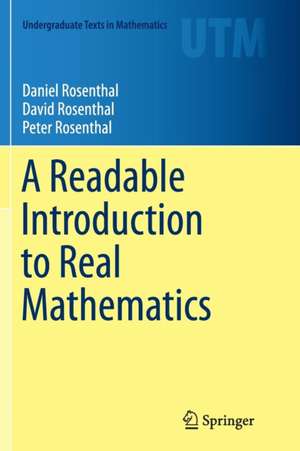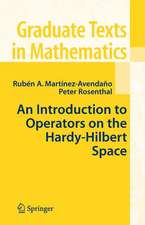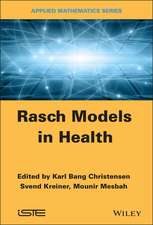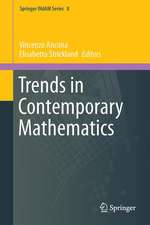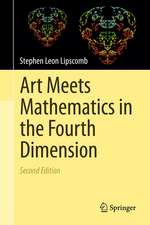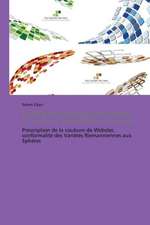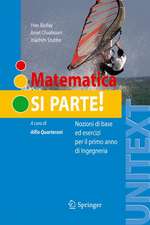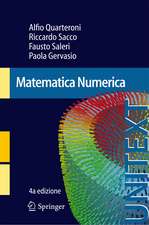A Readable Introduction to Real Mathematics: Undergraduate Texts in Mathematics
Autor Daniel Rosenthal, David Rosenthal, Peter Rosenthalen Limba Engleză Paperback – 16 sep 2016
| Toate formatele și edițiile | Preț | Express |
|---|---|---|
| Paperback (2) | 276.27 lei 38-45 zile | |
| Springer – 16 sep 2016 | 276.27 lei 38-45 zile | |
| Springer International Publishing – 28 iul 2021 | 386.00 lei 6-8 săpt. | |
| Hardback (1) | 368.78 lei 38-45 zile | |
| Springer International Publishing – 11 apr 2019 | 368.78 lei 38-45 zile |
Din seria Undergraduate Texts in Mathematics
- 17%
 Preț: 362.13 lei
Preț: 362.13 lei - 17%
 Preț: 365.42 lei
Preț: 365.42 lei -
 Preț: 257.71 lei
Preț: 257.71 lei -
 Preț: 370.77 lei
Preț: 370.77 lei -
 Preț: 449.60 lei
Preț: 449.60 lei - 17%
 Preț: 368.60 lei
Preț: 368.60 lei -
 Preț: 339.36 lei
Preț: 339.36 lei - 17%
 Preț: 366.38 lei
Preț: 366.38 lei - 17%
 Preț: 395.93 lei
Preț: 395.93 lei -
 Preț: 380.26 lei
Preț: 380.26 lei -
 Preț: 372.26 lei
Preț: 372.26 lei - 17%
 Preț: 373.59 lei
Preț: 373.59 lei - 17%
 Preț: 367.24 lei
Preț: 367.24 lei -
 Preț: 358.10 lei
Preț: 358.10 lei - 13%
 Preț: 389.61 lei
Preț: 389.61 lei -
 Preț: 304.91 lei
Preț: 304.91 lei - 17%
 Preț: 362.67 lei
Preț: 362.67 lei - 19%
 Preț: 368.78 lei
Preț: 368.78 lei - 19%
 Preț: 400.52 lei
Preț: 400.52 lei -
 Preț: 400.42 lei
Preț: 400.42 lei -
 Preț: 332.02 lei
Preț: 332.02 lei -
 Preț: 359.48 lei
Preț: 359.48 lei -
 Preț: 415.94 lei
Preț: 415.94 lei -
 Preț: 407.96 lei
Preț: 407.96 lei -
 Preț: 407.62 lei
Preț: 407.62 lei -
 Preț: 398.77 lei
Preț: 398.77 lei - 15%
 Preț: 417.73 lei
Preț: 417.73 lei -
 Preț: 402.33 lei
Preț: 402.33 lei -
 Preț: 400.42 lei
Preț: 400.42 lei -
 Preț: 440.01 lei
Preț: 440.01 lei -
 Preț: 433.85 lei
Preț: 433.85 lei -
 Preț: 424.14 lei
Preț: 424.14 lei -
 Preț: 395.09 lei
Preț: 395.09 lei -
 Preț: 367.40 lei
Preț: 367.40 lei -
 Preț: 364.40 lei
Preț: 364.40 lei -
 Preț: 290.80 lei
Preț: 290.80 lei -
 Preț: 298.00 lei
Preț: 298.00 lei -
 Preț: 329.94 lei
Preț: 329.94 lei - 19%
 Preț: 492.82 lei
Preț: 492.82 lei -
 Preț: 396.24 lei
Preț: 396.24 lei -
 Preț: 390.08 lei
Preț: 390.08 lei - 15%
 Preț: 521.04 lei
Preț: 521.04 lei -
 Preț: 402.00 lei
Preț: 402.00 lei - 15%
 Preț: 531.72 lei
Preț: 531.72 lei - 15%
 Preț: 447.81 lei
Preț: 447.81 lei - 15%
 Preț: 533.53 lei
Preț: 533.53 lei -
 Preț: 390.08 lei
Preț: 390.08 lei
Preț: 276.27 lei
Nou
Puncte Express: 414
Preț estimativ în valută:
52.87€ • 55.27$ • 44.68£
52.87€ • 55.27$ • 44.68£
Carte tipărită la comandă
Livrare economică 03-10 martie
Preluare comenzi: 021 569.72.76
Specificații
ISBN-13: 9783319379500
ISBN-10: 331937950X
Pagini: 173
Dimensiuni: 155 x 235 x 10 mm
Greutate: 0.25 kg
Ediția:Softcover reprint of the original 1st ed. 2014
Editura: Springer
Colecția Springer
Seria Undergraduate Texts in Mathematics
Locul publicării:Cham, Switzerland
ISBN-10: 331937950X
Pagini: 173
Dimensiuni: 155 x 235 x 10 mm
Greutate: 0.25 kg
Ediția:Softcover reprint of the original 1st ed. 2014
Editura: Springer
Colecția Springer
Seria Undergraduate Texts in Mathematics
Locul publicării:Cham, Switzerland
Recenzii
“It
is
carefully
written
in
a
precise
but
readable
and
engaging
style
and
is
tightly
organised
into
eight
short
‘core’
chapters
and
four
longer
standalone
‘extension’
chapters.
…
I
thoroughly
enjoyed
reading
this
recent
addition
to
the
Springer
Undergraduate
Texts
in
Mathematics
series
and
commend
this
clear,
well-organised,
unfussy
text
to
its
target
audiences.”
(Nick
Lord,
The
Mathematical
Gazette,
Vol.
100
(547),
2016)
“The book is an introduction to real mathematics and is very readable. … The book is indeed a joy to read, and would be an excellent text for an ‘appreciation of mathematics’ course, among other possibilities.” (G. A. Heuer, Mathematical Reviews, February, 2015)
“Daniel Rosenthal and Peter Rosenthal (both, Univ. of Toronto) and David Rosenthal (St. John's Univ.) present well-chosen, basic, conceptual mathematics, suitably accessible after a K-12 education, in a detailed, self-conscious way that emphasizes methodology alongside content and crucially leads to an ultimate clear payoff. … Summing Up: Recommended. Lower-division undergraduates and two-year technical program students; general readers.” (D. V. Feldman, Choice, Vol. 52 (6), February, 2015)
“The book is an introduction to real mathematics and is very readable. … The book is indeed a joy to read, and would be an excellent text for an ‘appreciation of mathematics’ course, among other possibilities.” (G. A. Heuer, Mathematical Reviews, February, 2015)
“Daniel Rosenthal and Peter Rosenthal (both, Univ. of Toronto) and David Rosenthal (St. John's Univ.) present well-chosen, basic, conceptual mathematics, suitably accessible after a K-12 education, in a detailed, self-conscious way that emphasizes methodology alongside content and crucially leads to an ultimate clear payoff. … Summing Up: Recommended. Lower-division undergraduates and two-year technical program students; general readers.” (D. V. Feldman, Choice, Vol. 52 (6), February, 2015)
Caracteristici
Presents
sophisticated
ideas
in
algebra
and
geometry
in
an
elementary
fashion
Includes exercises of varying difficulty to help motivate and teach the reader
Develops mathematical thinking that will be useful for future mathematics teachers and mathematics majors
Solutions to selected exercises are freely available in PDF
Includes exercises of varying difficulty to help motivate and teach the reader
Develops mathematical thinking that will be useful for future mathematics teachers and mathematics majors
Solutions to selected exercises are freely available in PDF
Cuprins
Preface to the Second Edition.- Preface for Readers.- Preface for Instructors.- 1. Introduction to the Natural Numbers.- 2. Mathematical Induction.- 3. Modular Arithmetic.- 4. The Fundamental Theorem of Arithmetic.- 5. Fermat's Theorem and Wilson's Theorem.- 6. Sending and Receiving Coded Messages.- 7. The Euclidean Algorithm and Applications.- 8. Rational Numbers and Irrational Numbers.- 9. The Complex Numbers.- 10. Sizes of Infinite Sets.- 11. Fundamentals of Euclidean Plane Geometry.- 12. Constructability.- 13. An Introduction to Infinite Series.- 14. Some Higher Dimensional Spaces.- Index.
Notă biografică
Daniel Rosenthal obtained his mathematics degree from the University of Toronto.
David Rosenthal is Professor of Mathematics at St. John's University in New York City.
Peter Rosenthal is Professor Emeritus of Mathematics at the University of Toronto.
Textul de pe ultima copertă
Designed for an undergraduate course or for independent study, this text presents sophisticated mathematical ideas in an elementary and friendly fashion. The fundamental purpose of this book is to teach mathematical thinking while conveying the beauty and elegance of mathematics. The book contains a large number of exercises of varying difficulty, some of which are designed to help reinforce basic concepts and others of which will challenge virtually all readers. The sole prerequisite for reading this text is high school algebra. Topics covered include: * mathematical induction * modular arithmetic * the Fundamental Theorem of Arithmetic * Fermat's Little Theorem * RSA encryption * the Euclidean algorithm * rational and irrational numbers * complex numbers * cardinality * Euclidean plane geometry * constructibility (including a proof that an angle of 60 degrees cannot be trisected with a straightedge and compass)* infinite series * higher dimensional spaces.
This textbook is suitable for a wide variety of courses and for a broad range of students of mathematics and other subjects. Mathematically inclined senior high school students will also be able to read this book.
From the reviews of the first edition:
“It is carefully written in a precise but readable and engaging style… I thoroughly enjoyed reading this recent addition to the Springer Undergraduate Texts in Mathematics series and commend this clear, well-organised, unfussy text to its target audiences.” (Nick Lord, The Mathematical Gazette, Vol. 100 (547), 2016)
“The book is an introduction to real mathematics and is very readable. … The book is indeed a joy to read, and would be an excellent text for an ‘appreciation of mathematics’ course, among other possibilities.” (G.A. Heuer, Mathematical Reviews, February, 2015)
“Many a benighted book misguidedly addresses the need [to teach mathematical thinking] by framing reasoning, or narrowly, proof, not as pervasive modality but somehow as itself an autonomous mathematical subject. Fortunately, the present book gets it right.... [presenting] well-chosen, basic, conceptual mathematics, suitably accessible after a K-12 education, in a detailed, self-conscious way that emphasizes methodology alongside content and crucially leads to an ultimate clear payoff. … Summing Up: Recommended. Lower-division undergraduates and two-year technical program students; general readers.” (D.V. Feldman, Choice, Vol. 52 (6), February, 2015)
From the reviews of the first edition:
“It is carefully written in a precise but readable and engaging style… I thoroughly enjoyed reading this recent addition to the Springer Undergraduate Texts in Mathematics series and commend this clear, well-organised, unfussy text to its target audiences.” (Nick Lord, The Mathematical Gazette, Vol. 100 (547), 2016)
“The book is an introduction to real mathematics and is very readable. … The book is indeed a joy to read, and would be an excellent text for an ‘appreciation of mathematics’ course, among other possibilities.” (G.A. Heuer, Mathematical Reviews, February, 2015)
“Many a benighted book misguidedly addresses the need [to teach mathematical thinking] by framing reasoning, or narrowly, proof, not as pervasive modality but somehow as itself an autonomous mathematical subject. Fortunately, the present book gets it right.... [presenting] well-chosen, basic, conceptual mathematics, suitably accessible after a K-12 education, in a detailed, self-conscious way that emphasizes methodology alongside content and crucially leads to an ultimate clear payoff. … Summing Up: Recommended. Lower-division undergraduates and two-year technical program students; general readers.” (D.V. Feldman, Choice, Vol. 52 (6), February, 2015)
